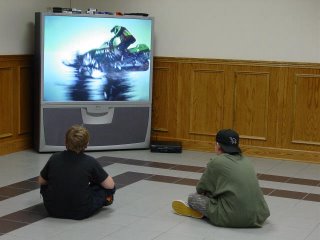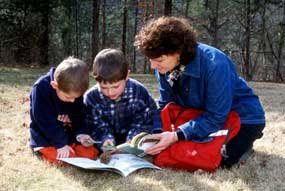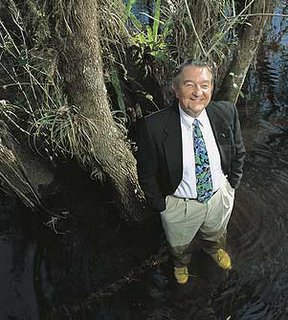|
|
|
|
||||||||||||||||||||||||||||||||||||||||||||||||||||||||
NWF Green Hour |
||||
Commentary on what parents should know about and can do to counteract common "nature deficit disorders" in our TV-watching, video game-playing children including encouraging a daily "Green Hour" of outside play and learning. A program of the National Wildlife Federation Sunday, November 27, 2005 Teaching gardens Children need green places for outdoor play. A little time each day involved in outdoor activity is good for them offering needed exercise and a calming of the nerves. Children also need good places to learn. In a recent article Washington Post writer Adrian Higgins describes an important trend in education -- what he calls "teaching gardens." Gardens provide a natural learning lab for kids. They let children step beyond the normal indoor world of schools and classrooms and into the natural world where that can learn with all their senses. The NWF and its statewide affiliates encourage schools to develop schoolyard habitats. These are wildlife gardens that that let children get beyond the indoor world and into a reversal of nature deficit disorder. Saturday, November 26, 2005 Good TV Health -- Guidelines Include More Outdoor Time The American Academy of Pediatrics has been looking hard at childhood television viewing and is not happy with what it is finding. The average child is now spending more time watching television than he or she spends in school! This is twice the maximum recommended by the Academy. Recent studies also recommend that children under two years of age be kept away from television entirely becaase it adversely affects critical cognitive development. So what is a parent to do? Here are some suggestions from the Academy on good TV health. I ncluded: outdoor time -- no surprise there. 1) Don’t have a TV in your child’s bedroom, 2) Have a home computer the child can have access to, 3) Turn off the TV during meals, 4) Let your children watch TV as a treat only after homework and chores are finished, 5) Have a TV-ban day, 6) Create fun alternatives to watching television, such as a board game, going outside, or listening to music . Read More Monday, November 14, 2005 More on Outdoor-oriented Kid Care Day care centers for preschoolers have become a way of life in modern America. It is the rare child today who stays out of day care in his or her younger years. Everyone knows that small children love to be outside but, sadly, not enough day care providers fully grasp how important this really is for a child's health and development. Pennsylvania State University has a program it calls Better Kid Care that emphasizes easy (and safe) outdoor activities for day care kids -- reading under trees, meals that are picnics, outdoor music and other activities. Read More! Tuesday, November 08, 2005 TV-Free Toddlers? & Greener Day Care! A recent study recommends that toddlers be kept away from television altogether. The authors conclude that the adverse effects of TV outweigh even the positive effects of such programs as the much-beloved Sesame Street. This raises a question about what kind of Green Hour treatment our toddlers usually receive. And. in modern U.S. society, that means looking at the day care and nursery school experience too. The North Carolina State University's Extension Service has some important ideas on this. In a fascinating project they have designed an outdoor space for day care that brings a more natural experience to toddlers and other young children. Check it out!  One Man's Woods We recently had a chance to meet with and talk to one of our favorite people. Richard Louv, author of Last Child in the Woods: Saving Our Children from Nature Deficit Disorder, attended and spoke at a national meeting at the National Conservation Training Center on the future of the conservation education. The meeting was hosted by the Paul F. Brandwein Institute and Richard made a plenary address. Photo from RichardLouv.com His highly-regarded book has brought national attention and focus to the fact that, in the past five to eight years, the impossible has happened -- especially if you grew up more than ten years ago. Today, American Children have pretty much stopped playing outside! In his address, Richard spoke of his own childhood and how, through endless time in a small neighborhood woods in Kansas, his love affair with nature and the outdoors took hold. His local woods gave him an affection for the natural world that ultimately produced a life of writing about family and nature and then the Last Child book with its accompanying sense of urgency and loss. His work is helping the National Wildlife Federation and many like-minded conservation organizations and public agencies to have to face up to the idea that without more Green Hours, a generation will emerge with no real affection for nature or wildlife and little notion of why young Richard would have spent all that time in his Kansas woods.  A Greener Check Up? The American Academy of Pediatrics (AAP) is a professional association that has physician guidelines for child television viewing. These guidelines direct pediatricians to ask parents and their young patients about the amount of TV they watch each day and, if they find it is over done, to recommend limits for health reasons. The AAP recognizes that parents need to monitor for too much telelvision viewing and so it has also adopted family guidelines for use at home. We think the AAP should adopt "Green Hour" guidelines too! This way the examining physician would inquire if children were getting enough healthful outdoor time to stem obesity, the need for attention deficit medications and more. An average of one hour outside per day would be the perfect prescription for getting kids away from television and into a healthy outdoor world. Sunday, November 06, 2005 A Chat With the Reptilian Brain What happens when you start with wet feet? Florida Gulf Coast University has a remarkable professor named Bill Hammond (pictured here standing in one of his favorite swamps). Bill is a powerful blend of environmental education guru, accomplished community activist/builder, consultant and the most upbeat of all educators. We met him this weekend at a national forum on building a future for the conservation movement through education and career preparation. It was hosted by the Paul F. Brandwein Institute. What makes Professor Hammond more animated than anything else, is talking about his 30-year campaign to take young people from his school and schools in the surrounding county on a mucky walk through a wetland. Thousands have done it. It seems like simple common sense to engage a student through outdoor experiences, but Bill is an exacting scholar. He knows that his form of wetland immersion also ties to established brain science. At the very core of our mind is a brain stem that comes straight out of the spine -- very ancient and very basic -- all feeling and no cognition. This part of the brain is so basic, it is defined as the reptilian brain. Bill's scientific approach to the brain gets students wet, lets them smell, feel and hear their surroundings and may even offer a sense of danger. When the brain stem is thus engaged, so is the full mind. This kind of learning sinks very deep -- 300 million years deep. |
||||
|
|
||||||||||||||||||||||||||||||||
|
|
|
|
|||||||||||||||||||||||||||||||


